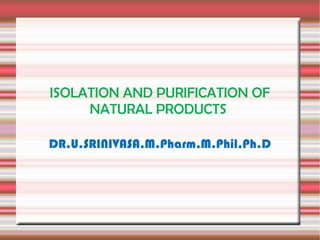
Isolation and Purification of natural products by using chromatography, Dr.U.Srinivasa, Professor and Head, Srinivas college of pharmacy, Mangalore
- 1. ISOLATION AND PURIFICATION OF NATURAL PRODUCTS DR.U.SRINIVASA,M.Pharm,M.Phil,Ph.D
- 2. METHODS 1. chromatographic techniques 2. Physical methods
- 3. Chromatography is a physical method of separation in which the components to be separated are distributed between two phases one of which is stationary (stationary phase) while the other (the mobile phase) moves through it in a definite direction.
- 4. The chromatographic process occurs due to differences in the distribution constant of the individual sample components.
- 5. Chromatographic methods 1.Thin layer chromatography 2. Column chromatography 3. Gas Liquid chromatography (GLC) 4. High Performance chromatography (HPLC) 5.Gel Filtration chromatography 6. Affinity chromatography 7.Paper chromatography
- 6. Chromatography : Is a technique used to separate and identify the components of a mixture. Works by allowing the molecules present in the mixture to distribute themselves between a stationary and a mobile medium.
- 7. Classification of chromatography according to mobile phase: 1 Liquid chromatography: mobile phase is a liquid. (LLC, LSC). 2 Gas chromatography : mobile phase is a gas. (GSC, GLC).
- 8. Classification according to the packing of the stationary phase: 1 Thin layer chromatography (TLC): the stationary phase is a thin layer supported on glass, plastic or aluminum plates. 2 Paper chromatography (PC): the stationary phase is a thin film of liquid supported on an inert support. 3 Column chromatography (CC): stationary phase is packed in a glass column.
- 9. Classification according to the force of separation: 1 Adsorption chromatography. 2 Partition chromatography. 3 Ion exchange chromatography. 4 Gel filtration chromatography. 5 Affinity chromatography.
- 10. Thin layer chromatography (TLC) Is a method for identifying substances and testing the purity of compounds. TLC is a useful technique because it is relatively quick and requires small quantities of material.
- 11. Separations in TLC involve distributing a mixture of two or more substances between a stationary phase and a mobile phase. The stationary phase: is a thin layer of adsorbent (usually silica gel or alumina) coated on a plate.
- 12. The mobile phase: is a developing liquid which travels up the stationary phase, carrying the samples with it. Components of the samples will separate on the stationary phase according to how much they adsorb on the stationary phase versus how much they dissolve in the mobile phase.
- 13. Thin Layer Chromatography (TLC)
- 15. TLC
- 16. Preparing the Chamber To a jar with a tight-fitting lid add enough of the appropriate developing liquid so that it is 0.5 to 1 cm deep in the bottom of the jar. Close the jar tightly, and let it stand for about 30 minutes so that the atmosphere in the jar becomes saturated with solvent.
- 17. Preparing the Plates for Development With a pencil, mark starting line ( 2 cm from the bottom of the plate) and finishing line ( About 10 cms from the starting line) Apply the sample by using capillary tube on the starting line
- 18. Developing the Plates After preparing the development chamber and spotting the samples, the plates are ready for development. When the plates are removed from the chamber, quickly trace the solvent front (the highest solvent level on the plate) with a pencil.
- 19. Identifying the Spots (visualization) If the spots can be seen, outline them with a pencil. If no spots are obvious, the most common visualization technique is to hold the plate under a UV lamp. Many organic compounds can be seen using this technique, and many commercially made plates often contain a substance which aids in the visualization of compounds.
- 20. Visualizing Agents Alkaloids: Dragendorff’s reagent Cardiac glycosides: Antimony trichloride Sugar: Aniline phthalate Amino acids: Ninhydrin
- 21. Interpreting the Data The Rf (retention factor) value for each spot should be calculated. It is characteristic for any given compound on the same stationary phase using the same mobile phase for development of the plates.
- 22. Hence, known Rf values can be compared to those of unknown substances to aid in their identifications.
- 24. Column Chromatography (CC) This includes chromatographic methods in which: The stationary phase is packed into a column. The mobile phase is a moving liquid or gas.
- 25. PRINCIPAL: The components are separated on the basis of their power of absorption on silica gel. Different compounds travel in the form of the bands . Fractions are collected from the bottom. Simultaneously TLC of all the fractions is performed. The fractions having same TLC pattern are mixed together and are evaporated to dryness to obtain the pure compound.
- 27. APPLICATIONS : It is the one of the commonly used techniques for the separation and purification of plant constituents
- 28. In addition to the above complicated techniques the following simple physical techniques are also used for separating and purifying the plant constituents a) Fractional crystallization b) Fractional liberation c) Steam distillation e) Fractional distillation f ) Sublimation
- 29. FRACTIONAL CRYSTALLIZION Crystallization is an old but an important method for the purification of compounds from the mixture Crystallization mostly depends upon the inherent character of the compound which form the crystals at the point of super- saturation in solvent in which it is soluble.
- 30. Compounds such as Sugars, Glycosides, Steroids, Triterpenoids, Flavanoids etc., show crystalline nature with certain exceptions
- 31. Methods of crystallization 1. Concentration 2. Slow evaporation 3. Refrigeration Based on differences in solubility of the components of a mixture in a particular solvents Valuable for resolution of often otherwise intractable mixtures
- 32. Eg: Picrates of alkaloids Osazone of sugars are isolated by this method
